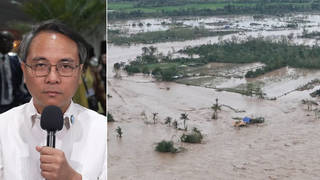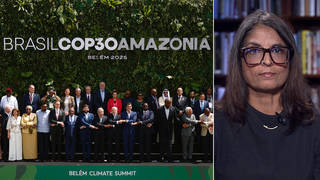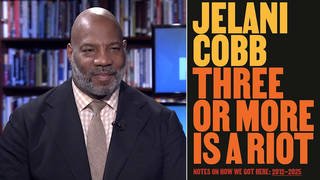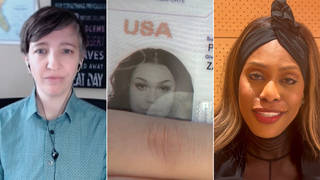
Guests
- Raymond Santanaone of the Central Park Five. His conviction was overturned after the real rapist confessed to the crime.
- Sarah Burnsdirected and produced the new documentary, The Central Park Five, along with her father, award-winning filmmaker Ken Burns, and her husband, David McMahon. It has opened in theaters this week and is playing in New York City at the IFC Center and Lincoln Plaza Cinemas. She is also the author of the 2011 book, The Central Park Five: The Untold Story Behind One of New York City’s Most Infamous Crimes.
- Natalie Byfieldwas a reporter for the Daily News at the time of Central Park Five case and is featured in the new documentary. She is now an assistant professor of sociology at St. John’s University in Queens. Her forthcoming book is called Savage Portrayals: Race, Media, and the Central Park Jogger Story.
Links
- “The Central Park Five” Film Website (IMDB)
- “The Central Park Five” Facebook page
- “City Subpoenas Film Outtakes as It Defends Suit by Men Cleared in ’89 Rape” (New York Times)
- Central Park 5 Are Cleared! (Democracy Now! Report From 2002)
- “The Central Park Five: The Untold Story Behind One of New York City's Most Infamous Crimes
- “The Central Park Five: The Untold Story Behind One of New York City's Most Infamous Crimes." By Sarah Burns. (Random House, 201
- "Savage Portrayals: Race, Media and the Central Park Jogger Story." By Natalie Byfield. (Temple University Press, Forthcoming)
- “New Verdict on Crime That Transfixed City.” By Steve Dollar (The Wall Street Journal)
- Award-winning Filmmaker Ken Burns and Raymond Santana Discuss Film at Toronto International Film Festival (Hollywood Reporter)
An explosive new documentary looks at a case once referred to as “the crime of the century”: the Central Park Five. Many people have heard about the case, but far too few know that innocent men were imprisoned as a result. The film tells the story of how five black and Latino teenagers were arrested in 1989 for beating and raping a white woman in New York City’s Central Park. Media coverage at the time portrayed the teens as guilty and used racially coded terms like “wolf pack” to refer to the group of boys accused in the attack. Donald Trump took out full-page ads in four city newspapers calling for the reinstatement of the death penalty so they could be executed. However, the convictions of the five were vacated in 2002 when the real rapist came forward and confessed to the crime, after the five defendants had already served sentences of almost seven to 13 years. New York City is refusing to settle a decade-long civil lawsuit brought by the men. And now lawyers for the city are seeking access to footage gathered for the new film. We speak to one of the Central Park Five, Raymond Santana; filmmaker Sarah Burns; and journalist Natalie Byfield. [includes rush transcript]
Transcript
NERMEEN SHAIKH: We turn now to an explosive new documentary co-directed by Ken Burns that looks at a case once referred to as, quote, “the crime of the century.” The film is called The Central Park Five. Many people have heard about the case, but far too few know that innocent men were imprisoned as a result.
The film tells the story of how five black and Latino teenagers were arrested in 1989 for beating and raping a white woman in New York City’s Central Park. She came to be known as the Central Park jogger. Media coverage at the time portrayed the teens as guilty and used racially coded terms like “wolf pack” to refer to the group of boys accused in the attack. Donald Trump took out full-page ads in four city newspapers calling for the reinstatement of the death penalty so they could be executed.
But in 2002, the convictions in the Central Park Five case were vacated after the real rapist came forward and confessed to the crime. DNA evidence confirmed he was the sole attacker. This came after the five defendants had already served sentences of almost seven to 13 years for the assault. To this day, their case continues to impact how the criminal justice system treats juvenile offenders.
This is the trailer for The Central Park Five.
JIM DWYER: I want us to remember what happened that day and be horrified by ourselves. New York in the late 1980s was a completely schizophrenic, divided city.
REV. AL SHARPTON: New York is now the capital of racial violence.
BERNHARD GOETZ: If I had more bullets, I would have shot them all again and again.
JIM DWYER: Criminality, gang wars, drug wars—we were supposed to be afraid. It would have been irrational not to be afraid.
UNIDENTIFIED: Off with the camera, man!
COMMISSIONER RICHARD CONDON: Last night, a woman jogger was found unconscious and partially clothed in Central Park. She was beaten and sexually assaulted.
ED KOCH: A woman jogging in Central Park. Central Park was holy. It was the crime of the century.
COMMISSIONER RICHARD CONDON: Five youths were arrested on 96th Street, all between 14 and 15 years of age.
ED KOCH: They got ’em!
SAUL KASSIN: You can only imagine the pressure to have this crime solved and solved quickly.
KEVIN RICHARDSON: First we was all together. Then they started to put us in different rooms, separately.
YUSEF SALAAM: “What did you do? Who were you with? Who did you come with?” The tone was very scary. I felt like they might take us to the back of the precinct and kill us.
KOREY WISE: You’re not going to go home until you give up a story.
RAYMOND SANTANA SR.: I told my son, “Go to the park,” that night. I feel guilty.
KEVIN RICHARDSON: I’m telling the guy, “I don’t know what you’re talking about.” They’re getting a little angry.
RAYMOND SANTANA: And they’re like, “You know you did it. Didn’t you?”
UNIDENTIFIED: He had been interrogated for over 24 hours. That amounts to pressure.
NATALIE BYFIELD: These young men were guilty. It was almost unquestioned.
LYNNELL HANCOCK: The police controlled the story. They created the story.
CALVIN O. BUTTS III: They seized on the fears of the people. “Wilding,” the bestial characterization of the black man.
MICHAEL WARREN: There’s no DNA match whatsoever to any of these boys.
RONALD GOLD: I was going nuts. No blood on the kids. Nobody could identify them. But if they confessed, they confessed, and that was that.
JIM DWYER: A lot of people didn’t do their jobs—reporters, police, prosecutors, defense lawyers.
UNIDENTIFIED: This was institutional protectionism.
CRAIG STEVEN WILDER: We falsely convicted them, and we walked away from our crime.
UNIDENTIFIED: This is the ultimate siren that says none of us is safe.
AMY GOODMAN: That is a trailer of The Central Park Five, which has just opened in theaters and has brought new attention to a case that continues to unfold well over a decade after it happened. Right now New York City is refusing to settle a civil lawsuit brought by the five men whose convictions were overturned after they spent years in prison, and now lawyers for the city are seeking access to footage gathered for the new film.
For more, we’re joined in our studio by three guests. Ray Santana is with us. Raymond Santana is one of the Central Park Five. His conviction was overturned after the real rapist confessed to the crime, Matias Reyes. Sarah Burns is with us. She directed and produced the new documentary, The Central Park Five, along with her father, the award-winning filmmaker Ken Burns, as well as her husband David McMahon. She is also author of the 2011 book, The Central Park Five: A Chronicle of a City Wilding. And we’re joined by Natalie Byfield. She was a reporter for the New York Daily News at the time of the Central Park Five case, featured in this new documentary, now an assistant professor of sociology at St. John’s University in Queens. Her forthcoming book is called Savage Portrayals: Race, Media, and the Central Park Jogger Story.
We welcome you all to Democracy Now! Sarah, let’s begin with you, how you got involved with this case.
SARAH BURNS: I was too young in 1989 to have followed it at all, and so I learned about it for the first time in 2003 as a college student interning for one of the civil rights lawyers who’s now involved in the civil suit. And so, I learned about the case, I met Raymond and Kevin that summer, and I became fascinated by this story, this miscarriage of justice and how it had happened. And so, I actually wrote my undergraduate thesis about it before turning my attention to working on the book and then the film.
AMY GOODMAN: I want to turn to a first clip of the film after the trailer. This is a most stunning story. And before we do, I wanted to ask—I wanted to ask about the New York Police Department and how it dealt. The NYPD’s assistant chief of detectives at the time, Aaron Rosenthal, made one of his first statements to the media about the Central Park jogger case shortly after the attack occurred.
ARRON ROSENTHAL: Approximately 1:30 this morning, two males walking through Central Park north of the 102nd Street jogging path found a female. She was still alive and, in fact, still is alive. The female was clad only in a bra. She was lying exposed in the area, appeared to have been exposed for a couple of hours, her body temperature down very low. Around her mouth was an article of clothing that was wrapped around her face, and the same article was used to bind her wrists to her face. She had been struck around the head repeatedly. Mud on her body. She appears to have been dragged through the woods north into the shrub area. She was taken to Metropolitan Hospital, where she’s classified as in serious condition.
AMY GOODMAN: That was one of the police chiefs at the time. Natalie Byfield, lay out the story for those who aren’t familiar, from 1989.
NATALIE BYFIELD: A woman was found early in the morning of April 20th, 1989, raped in the park. She was near dead, as the chief of—one of the head detectives here was saying. And then blanket coverage ensued in all of the newsrooms across the city.
AMY GOODMAN: Including yours, the New York Daily News.
NATALIE BYFIELD: Including mine, the New York Daily News. And this was one of more than some 3,000 rapes that were committed in the city that year. But what we had with this coverage was something much different. It was blanket coverage, the type of coverage that you see with a disaster, where all resources are deployed to cover this rape. And this intensity, this level of intensity in the coverage, continued for maybe the first two months of coverage.
And during this time, a particular narrative was developed about what this—what happened and what happened to the victim and also what this case was about. And the narrative really said that these young black and Latino teens—there was one person as young as 13, who was picked up and arrested in the time immediately after the incident, but these young black and Latino teens were on some type of—some type of mayhem, running through the park, and it manifested itself into the rape of this woman. And this type of thing is called “wilding,” because it’s a new type of incident. So we had the—we had in the coverage this sort of explanation that told the city, told the rest of the world, really, because it was covered internationally, that some new type of crime was developing across the city that was being committed by these young black and Latino male teens.
NERMEEN SHAIKH: But can you set out the scene here, though? One of the people, Jim Dwyer, I believe, from the New York Times in the documentary says that the way this case was represented in the media had to do—like the people who were actually convicted were proxies for other wars that were being fought in the city, had to do with crack cocaine coming into these neighborhoods, increasing rates of poverty, etc. Can you explain a little bit what the scene was?
NATALIE BYFIELD: Sure, in terms of the context of what was going on in the city and really in the nation at the time, there was this war on drugs that was being prosecuted across the nation. And in terms of this war on drugs being prosecuted, black and Latino male teens were the ones who were seen as the main problem in this drug crisis happening in the country. And then, of course, we had crack cocaine becoming a bigger and bigger problem in poor and minority communities. So, they became the target of all that was wrong—or they became the face of all that was wrong in society at the time. So, in that context, this case happened with that larger backdrop taking place. And once this incident happened, it really amped up in people’s minds the level of problem that black and Latino teens, male teens, represented and the fear that we needed to feel about this particular group of people.
And, well, what I wanted to add about that is that the drug crisis, the drug problem, existed across all strata and in all communities in the country. Youth violence was rising in all communities across the country. And the surgeon general, a little after this, did a study about this, and the fact that we targeted—we, as a society, targeted—young black and Latino teens as the problem is part of what was taking place.
AMY GOODMAN: We’re going to break again. When we come back, we’re going to hear from one of the Central Park Five, Raymond Santana, to talk about his experience. We are talking now almost 20—well, over 20 years ago. Stay with us.
[break]
AMY GOODMAN: Our guests are Sarah Burns, who is the director of this remarkable new film called The Central Park Five. We are also joined by the former New York Daily News reporter Natalie Byfield, who was there in 1989 in the newsroom when the attack on Trisha Meili took place. She wasn’t named for years, but she was the investment banker, the 28-year-old woman, a white woman, who was raped in Central Park. And we’re joined by Raymond Santana.
Raymond, before I ask about your experience, in this excerpt from The Central Park Five documentary, two of the defendants, [Yusef Salaam] and you, Raymond Santana, describe how detectives tried to play them against each other during their separate interrogations.
RAYMOND SANTANA: It got to one point where they pulled me, Yusef and Antron in a conference room. And a lawyer says, “You know, we’re going to lose this case. What we’re planning to do is see if we can get you a plea deal.”
YUSEF SALAAM: And I remember telling them, “You know, you guys can cop out, but if I did something, I would cop out. I would want the least amount of time for what I did. But if I didn’t do anything, you can give me the rest of my life in prison.” You know, I didn’t know what that meant back then, but I just knew that there would be no way that I would cop out to something that I didn’t do.
RAYMOND SANTANA: They said, “Well, it has to be all three of you guys, or it’s nobody.”
AMY GOODMAN: That was Raymond Santana and Yusef Salaam, another of the Central Park Five. Now let’s go to this next clip.
RAYMOND SANTANA: Hartigan sat down, and he said, “Look, Ray, I know you didn’t do anything wrong, but the other guys right now, they’re in other precincts, and they’re saying that you did it.”
KEVIN RICHARDSON: And they’re telling me, “Well, you’re not saying nothing, but these guys put your name in it.”
RAYMOND SANTANA: And I’m like, “I didn’t do anything.” And he’s like, “Well, this is why I’m here to help you, because I know you didn’t do anything. You’re a good kid. You know, this isn’t you.” He pulls out this picture of Kevin Richardson, and he goes, “You know this kid?” And I’m like, “No, I don’t know him.” And he goes, “You see the scratch under his eye? That came from the woman. We know he did it. He’s going down.”
KEVIN RICHARDSON: At this point, I’m like, you know, like, I don’t know these guys that’s there, so I’m just going to make up something and include these guys’ names.
RAYMOND SANTANA: OK, if—you know, if you’re going to do it to me, then I’m going to do it to you.
AMY GOODMAN: That’s Raymond Santana in the film and Kevin Richardson. Raymond, you were 14 years old, and so was Kevin.
RAYMOND SANTANA: Yes, that’s correct.
AMY GOODMAN: They, the police—where were your parents? Were they in the room? Did you have a lawyer?
RAYMOND SANTANA: No, I didn’t have a lawyer at that time. And my grandmother was present, but, you know, one of the police tactics that was used against us was they would pull her out the room, and—you know, and they would talk to her in the hallway. And as they talked to her in the hallway is when they started to really get aggressive towards me and use, you know, some of those tactics that we talked about in the film, yeah.
NERMEEN SHAIKH: And what happened once you—once you got out, once you got out of prison? I mean, you were—you stayed in prison, and then, after that, the sentence was only overturned once you were out, and then you were back in prison afterwards.
RAYMOND SANTANA: Yes.
NERMEEN SHAIKH: Can you talk about the narrative? Explain what happened.
RAYMOND SANTANA: Well, what happened was, once I came home, you know, from serving the prison term—
NERMEEN SHAIKH: How many years did you serve?
RAYMOND SANTANA: I served almost seven years. And so, what happened was that, you know, I tried to get my life back together and put one foot in front of the other, but I didn’t—you know, I didn’t realize the social death that we were given as a sentence. You know, this wasn’t a five to 15 or five to 10; this was a life sentence, a death sentence, in a sense, because, you know, when I came home, I couldn’t get employment. You know, I tried out—filled out numerous applications. And, you know, I had to register as a sex offender. You know, my whole neighborhood looked at me, you know, kind of strange. You know, you get the “Hi, how are you doing?” but, you know, you always have that bullseye on the back, you know, that says, someway, somehow, I’m Raymond Santana from the Central Park jogger case.
You know, my family shunned away from me, so I thought I was all alone. I had—you know, there was nowhere I can turn. There was no transitional programs for me to come back into society into, and so—and be productive. And so I crashed. And I didn’t know what to do. And I turned back to crime, and I started selling—you know, I started selling drugs. And I got charged—and I got arrested, and I was charged with criminal possession with the intent to distribute.
AMY GOODMAN: Now, you wouldn’t have been in jail that long except that you had this case before.
RAYMOND SANTANA: That’s correct.
AMY GOODMAN: This case that you ultimately were wrongly imprisoned for. I have a connection to this case, because a woman in my apartment building was the last one raped by Matias Reyes, the man—and he was caught by our doorman—
RAYMOND SANTANA: Yes.
AMY GOODMAN: —as he tried to race out of the building. This is the man who would later testify that he did the rape. And, of course, the DNA matched and everything. Where were you when you heard the news that you were being exonerated and you would be released, that the real rapist of Trisha Meili had come forward?
RAYMOND SANTANA: I was in Franklin Correctional Facility in Malone County, which is about eight to nine hours away from New York City. And, you know, and previously, before that, I was in Downstate Correctional, and that’s where I actually got the news. You know, I called my dad, and he told me that Reyes had came forward. And I didn’t believe him. I was so also institutionalized by that point that I just felt that Morgenthau from the DA’s office would just sweep it under the rug, they would try to make him the sixth man, and I would just go to grave with this label, the Central Park jogger—Central Park Five, on my back.
AMY GOODMAN: So you sued, along with the other men—
RAYMOND SANTANA: Yes.
AMY GOODMAN: —who are now men. You were boys then. You were 14 years old when this all started.
RAYMOND SANTANA: Yes.
AMY GOODMAN: It’s 20—more than 20 years later. What’s happened?
RAYMOND SANTANA: Well, you know, right now we’re currently in depositions, you know, with no end in sight. The city loves to use these tactics against us.
AMY GOODMAN: Sarah Burns, they asked for outtakes of your film?
RAYMOND SANTANA: Yes.
SARAH BURNS: Yes, they served us with a subpoena a couple months ago, asking for, initially, everything we’d collected: notes, outtakes, footage, everything. And when we pushed back, they responded with a new subpoena that was narrowed somewhat. But we feel that we’re protected by the shield laws for journalists, and so we filed a motion to quash the subpoena.
AMY GOODMAN: You’ve spoken with Trisha Meili?
SARAH BURNS: I did speak with her early on—
AMY GOODMAN: The victim.
SARAH BURNS: —in the process of the book. I obviously wanted to hear what she had to say about it.
AMY GOODMAN: What did she say about these men, now that it is absolutely confirmed that Matias Reyes was the rapist? He had used this MO over and over again.
SARAH BURNS: She doesn’t really comment on it. She chose at that time not to participate in the book or the film project. And, you know, she wrote her own book that was published in 2003 about her recovery from what was not only a brutal rape but also a traumatic brain injury. And so, she was not expected to live. She was in a coma for nearly two weeks and really made a miraculous recovery. And so, she sort of focused more on that part of her story and has really declined to talk about this question that was later raised about what actually happened.
AMY GOODMAN: Well, we will continue this conversation and post it online at democracynow.org. A remarkable film, Sarah. It’s opening around the country now. Sarah Burns is the director, together with her father Ken Burns; Natalie Byfield, the reporter; Raymond Santana, the prisoner, now freed.











Media Options